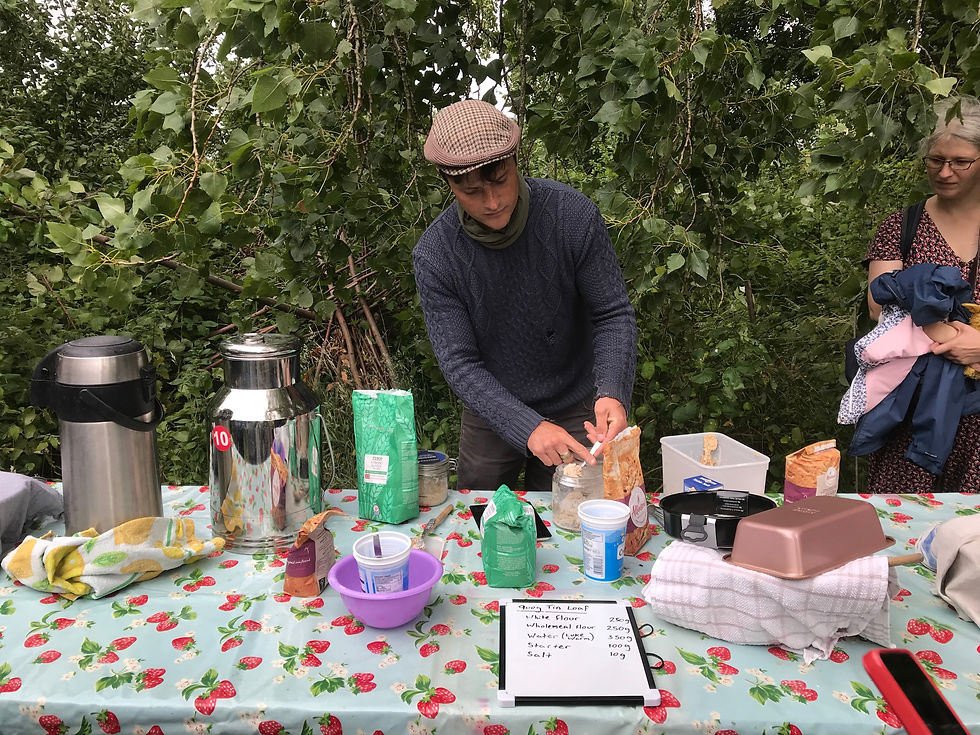SOURDOUGH: A BEGINNER'S GUIDE
- Global Gardens
- Aug 12, 2023
- 3 min read
By Community Baker Will Armstrong

In this blog Community Baker provides a step-by-step guide to baking the perfect sourdough lof.
Maintaining Your Sourdough Starter
Your starter needs to be at peak activity for successful baking. If you aren’t baking every day, you can keep your starter in the fridge but will need to build your starter before you bake with it. This is a two-stage process, known as double refreshment, which will leave you with a second- build starter.
INGREDIENTS
30g starter
60g water at 16-18°C (cool water)
50g white bread flour
50g wholegrain/ wholemeal flour
Day 1@ 8pm (first build)
Remove your starter from the fridge then place 30g of starter in a clean jar with the water and whisk together well. This will oxygenate the water. Add the flours and stir vigorously to combine the ingredients. Cover the jar with a loose lid to allow gases produced to escape. Leave the jar on the kitchen work surface overnight at an ambient temperature of 20°C-22°C.
Day 2@ 8am (second build)
Take 30g of your starter from your first build and refresh it again following the instructions for the first build (Discard or make crepes from the leftover starter) Leave your jar for a further 8-12 hours before baking. This process builds up the microbes in your starter so that it is ready for baking. Your starter will rise over this period and you want to use it when it has peaked in its rise.
Basic sourdough 50:50 tin loaf
This is an everyday entry level sourdough loaf. By making this often, you will become familiar with the rhythm of making sourdough. Get this one right and you have the foundational skills for exploring all other sourdough bakes.
MAKES 1 LARGE LOAF (900G LOAF TIN)
INGREDIENTS
375g water at 27°C (lukewarm)
100g bubbly, lively second-build
starter
250g white bread flour
250g wholegrain/ wholemeal flour
10g fine sea salt
Day 1@8pm First build - Refresh your starter
Day 2@8am Second build - Refresh your starter
Day 2@6pm Mix - the first stage of mixing your dough
Day 2@ 6:30pm Bassinage - - the second stage of mixing your dough, incorporating the remaining water
LEAVE FOR 30 MINUTES
Day 2@7pm Prove - Transfer your dough into the prepared tin and leave, covered
Day 3@8am Bake - Preheat your oven and bake

Basic sourdough 50:50 tin loaf - Method
1. Before you mix your dough, you will need to refresh your starter twice to make a nice active starter
Mix
2. In a large bowl, mix together 350g of the water and the sourdough starter, then add the flours and salt and mix your dough vigorously using a strong spoon for about 2 minutes. Leave to rest for 30 minutes
Bassinage
3. When the gluten has had 30 minutes to develop, you can begin your bassinage. Bassinage is the technique of adding water to dough over a period of time
4. Add the remaining 25g of your water to the bowl. You will be using your hands to mix this in. With a slightly damp hand, place your hand in the dough with firm open fingers, and gently close your fingers whilst twisting the dough anti-clockwise drawing the dough through your fingers as you do so. This action mimics a dough hook. The dough shouldn’t stick too much to your hands if it has rested enough. Every couple of movements, wet your hands once more, shaking off any excess water then continue your dough hook hand kneeding. This should take around 2 minutes. Cover and leave for another 30 minutes
Prove
5. Grease a 900g loaf tin and line with baking paper, then place the dough in the tin. Cover with a tea towel or shower cap and
leave to prove on the kitchen worktop overnight.
Baking Your Bread
1) Put one oven tray on the first shelf from the bottom
2) Put second oven tray on the middle shelf
3) Preheat your oven on fan setting to 220°C for 30 minutes
4) Fill a cup full of boiling water just before loading the bread
5) Keeping the oven door open for minimum time possible, load your bread onto the oven tray on the middle shelf
6) Pour the cup of boiling water onto the lower oven shelf creating lots of steam
7) Close the oven door as quick as possible to keep the steam inside the oven
8) Bake for 25 minutes
9) Remove bread from the tin & baking paper then return it to the oven
10) Bake for a further 10-30 minutes depending on how dark you like your crust
11) Once cool, store your loaf wrapped in a dry tea towel.
Best eaten within 3-4 days.

Loaf made by Sally and Violet












Comments